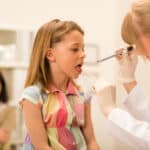According to the Centers for Disease Control and Prevention (CDC), hearing loss is one of the most common disabilities among children with nearly 15% of kids ages five to nine showing at least some symptoms of hearing difficulty. Earlier this year, American Girl and Mattel announced that it will honor children with hearing loss by releasing a doll just like them.
Introducing Joss Kendrick
Together with surfer Caroline Marks, the toy company designed a surfing American doll with brown hair, brown eyes, and a hearing aid. It is one of the first of its kind and 2020’s Girl of the Year doll. In the official press release, Mattel describes Joss as “a fierce athlete born with hearing loss and a passion for surfing and competitive cheer” and an important part of its “lineup of inspirational characters who impart meaningful life lessons to help girls learn and grow with confidence.”
The company also released books telling Joss’s story and a weekly YouTube series for kids called “Meet Joss.” Joss, the American Girl books, and all related accessories went on sale December 31, 2019.
Raising Awareness About Hearing Loss
With its release of the new doll, American Girl is donating $25,000 to the Hearing Loss Association of America (HLAA) and collecting additional donations from any customers who would like to contribute. The company will also lend its support to HLAA’s 15th annual Walk4Hearing. HLAA strives to educate the public about hearing loss symptoms, hearing aids and hearing assistive technology, support in local and national communities, and financial aid options for those who may need assistance to visit the doctor.
Recognizing The Symptoms And Preventative Care
What are the symptoms of hearing loss? It can be difficult to identify hearing problems in babies, especially when infants are too young to effectively communicate or talk. Ear, nose, and throat doctors recommend keeping an eye out for any of the following symptoms:
- No reaction to loud sounds. Even from birth to three months, children should react when they hear especially loud noises. Starting at four to six months, infants should start looking around and trying to identify the source of loud noises.
- Responds to visual clues, but not audio ones. According to the Centers for Disease Control and Prevention (CDC), if your child looks at you when you are nearby and when you move but does not react to his or her name, your child may be experiencing some hearing loss.
- Babbles only. Babies with hearing loss generally do not move onto babbling that more closely resembles speech. Infants should say their first few words–or something close to it–in the first 12 months. It’s very likely that a child without any hearing problems will say hi, bye, mama, or dada in their first year.
If your child is exhibiting any of these symptoms, especially as an infant or toddler, this hearing loss is likely genetic. In most cases, doctors will test babies’ hearing when they are born. If this wasn’t done, doctors recommend a hearing screening within the first one to three months. About 50% of hearing loss or hearing impairment in very young children, including toddlers and babies, is due to genetic causes, CDC data shows. It is important for any parents who suspect hearing loss or difficulties to have their child evaluated by a doctor.
Not all hearing loss is genetic. Some may be caused by severe infections, normal infections that remain untreated, or loud noises. Remember that even normal ailments like swimmer’s ear should get better, not worse. If your child is still showing symptoms of swimmer’s ear after seven to 10 days–or if their symptoms are increasing in severity–they need to see a doctor. Keep babies and toddlers away from loud music, traffic, or appliances that may induce hearing loss.
Hearing loss among very young children is fairly common–and can lead to speech delays if not detected early. Tools like Joss raise awareness and can help boost morale for children with hearing loss and hearing aids. According to a study published in Communication Research, representation of different genders, races, and those with disabilities is important and has positive effects on self-esteem.



